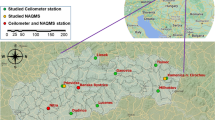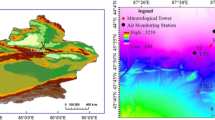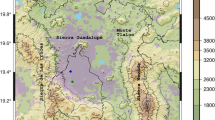Abstract
The diurnal and seasonal variability of the mixed-layer height in urban areas has implications for ground-level air pollution and the meteorological conditions. Measurements of the backscatter of light pulses with a commercial lidar system were performed for a continuous period of almost six years between 2011 and 2016 in the southern part of Mexico City. The profiles were temporally and vertically smoothed, clouds were filtered out, and the mixed-layer height was determined with an ad hoc treatment of both the filtered and unfiltered profiles. The results are in agreement when compared with values of mixed-layer height reconstructed from, (i) radiosonde data, and (ii) surface and vertical column densities of a trace gas. The daily maxima of the mean mixed-layer height reach values \(> 3\hbox { km}\) above ground level in the months of March–April, and are clearly lower (\(< 2.7\hbox { km}\)) during the colder months from September–December. Mean daily minima are typically observed at 0700 local time (UTC − 6h), and are lowest during the winter months with values on average below 500 m. The data presented here show an anti-correlation between high-pollution episodes and the height of the mixed layer. The growth rate of the convective mixed-layer height has a seasonal behaviour, which is characterized together with the mixed-layer-height anomalies. A clear residual layer is evident from the backscattered signals recorded in days with specific atmospheric conditions, but also from the cloud-filtered mean diurnal profiles. The occasional presence of a residual layer results in an overestimation of the reported mixed-layer height during the night and early morning hours.







Similar content being viewed by others
References
Baumgardner D, Grutter M, Allan J, Ochoa C, Rappenglueck B, Russell L, Arnott P (2009) Physical and chemical properties of the regional mixed layer of mexico’s megapolis. Atmos Chem Phys 9(15):5711–5727
Bezanilla A, Krueger A, Stremme W, Grutter M (2014) Solar absorption infrared spectroscopic measurements over Mexico City: methane enhancements. Atmósfera 27(2):173–183
Bossert JE (1997) An investigation of flow regimes affecting the Mexico City region. J Appl Meteorol 36(2):119–140
Bossioli E, Tombrou M, Dandou A, Athanasopoulou E, Varotsos KV (2009) The role of planetary boundary-layer parameterizations in the air quality of an urban area with complex topography. Boundary-Layer Meteorol 131(1):53–72
Doran JC, Abbott S, Archuleta J, Bian X, Chow J, Coulter R, de Wekker SFJ, Edgerton S, Elliott S, Fernandez A, Fast JD, Hubbe JM, King C, Langley D, Leah J, Lee JT, Martin TJ, Martinez D, Martinez JL, Mercado G, Mora V, Mulhearn M, Pena JL, Petty R, Porch W, Russell C, Salas R, Shannon JD, Shaw WJ, Sosa G, Tellier L, Templeman B, Watson JG, White R, Whiteman CD, Wolfe D (1998) The IMADA-AVER boundary layer experiment in the Mexico City area. Bull Am Meteorol Soc 79(11):2497
Eresmaa N, Karppinen A, Joffre SM, Räsänen J, Talvitie H (2006) Mixing height determination by ceilometer. Atmos Chem Phys 6(6):1485–1493. https://doi.org/10.5194/acp-6-1485-2006
Grabon JS, Davis KJ, Kiemle C, Ehret G (2010) Airborne lidar observations of the transition zone between the convective boundary layer and free atmosphere during the International H2O Project (IHOP) in 2002. Boundary-Layer Meteorol 134(1):61–83
Helmis C, Sgouros G, Tombrou M, Schäfer K, Münkel C, Bossioli E, Dandou A (2012) A comparative study and evaluation of mixing-height estimation based on sodar-rass, ceilometer data and numerical model simulations. Boundary-Layer Meteorol 145(3):507–526
Joffre S, Kangas M, Heikinheimo M, Kitaigorodskii S (2001) Variability of the stable and unstable atmospheric boundary-layer height and its scales over a boreal forest. Boundary-Layer Meteorol 99(3):429–450
Lotteraner C, Piringer M (2016) Mixing-height time series from operational ceilometer aerosol-layer heights. Boundary-Layer Meteorol 161(2):265–287
Münkel C (2007) Mixing height determination with lidar ceilometers-results from Helsinki testbed. Meteorol Z 16(4):451–459
Perez Vidal H, Raga G (2009) On the vertical distribution of pollutants in Mexico City. Atmósfera 11(2):95–108
Piringer M, Joffre S, Baklanov A, Christen A, Deserti M, De Ridder K, Emeis S, Mestayer P, Tombrou M, Middleton D, Baumann-Stanzer K, Dandou A, Karppinen A, Burzynski J (2007) The surface energy balance and the mixing height in urban areas—activities and recommendations of COST-Action 715. Boundary-Layer Meteorol 124(1):3–24
Schaefer K, Flores-Jardines E, Emeis S, Grutter M, Kurtenbach R, Wiesen P, Müenkel C (2009) Determination of mixing layer heights by ceilometer and influences upon air quality at Mexico City airport. Proc SPIE 7475(74):750M
Seibert P, Beyrich F, Gryning SE, Joffre S, Rasmussen A, Tercier P (2000) Review and intercomparison of operational methods for the determination of the mixing height. Atmos Environ 34(7):1001–1027
Stremme W, Ortega I, Grutter M (2009) Using ground-based solar and lunar infrared spectroscopy to study the diurnal trend of carbon monoxide in the Mexico City boundary layer. Atmos Chem Phys 9(20):8061–8078. https://doi.org/10.5194/acp-9-8061-2009
Teschke G, Reichardt J, Engelbart D (2008) Wavelet algorithm for the estimation of mixing layer height with ceilometers. In: Reviewed and revised papers presented at the 24th international laser radar conference (ILRC), Citeseer, pp 23–27
Whiteman CD, Zhong S, Bian X, Fast J, Doran J (2000) Boundary layer evolution and regional-scale diurnal circulations over the Mexico Basin and Mexican plateau. J Geophys Res: Atmos 105(D8):10081–10102
Acknowledgements
This investigation was funded by DGAPA-UNAM Grant No. IN107417 and Conacyt Nos. 249374 & 275239. The RUOA network (Red Universitaria de Observatorios Atmosféricos) from the Universidad Nacional Autónoma de México is acknowledged for making the data available, with technical support from D. Flores, O. López, W. Gutiérrez, M. García and M.A. Robles. We thank I. Ortega for discussions and T. Blumenstock and F. Hase from the KIT for their cooperation in setting up the NDACC site in Altzomoni.
Author information
Authors and Affiliations
Corresponding author
Rights and permissions
About this article
Cite this article
García-Franco, J.L., Stremme, W., Bezanilla, A. et al. Variability of the Mixed-Layer Height Over Mexico City. Boundary-Layer Meteorol 167, 493–507 (2018). https://doi.org/10.1007/s10546-018-0334-x
Received:
Accepted:
Published:
Issue Date:
DOI: https://doi.org/10.1007/s10546-018-0334-x




